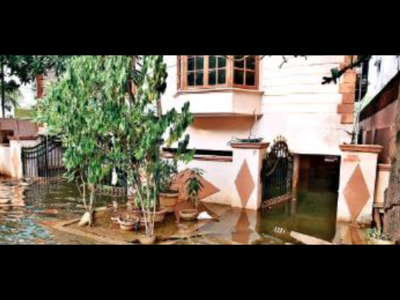The Times of India 11.11.2010
Bangalore Patrol: High on water, low on public amenities
BANGALORE: What makes a city livable? What attracts people to one part of the city even as some other areas repel? Unfortunately, after six decades of independence it remains bijli, sadak and pani. It’s the simple things of life; good water connectivity, regular and quality supply of power, decent roads, speedy, timely transport connections, nice parks and playgrounds to stroll and play in, good air to breathe and of course, safe neighbourhoods where people, especially women, can move around without fear that define quality of life.
Simple as they may seem, these services are difficult to deliver on the ground. Bangalore Patrol’s study of the city’s 198 wards reveals that shockingly, on several parameters, substantial parts of the city score zero implying pathetic quality in the delivery of the very basic of services.
Bangalore Patrol has studied six parameters: water, mobility (roads, transport), sanitation, public amenities, environment, and crime. Power, is the only important service that has not been included in this study, mainly for technical reasons. Of those measured, the city has the highest scores for water and the lowest for public amenities. Given the water woes of the city, that Bangalore has the best scores for this parameter is a pleasant surprise. This good score is because the city has very good pipeline coverage.
That Bangalore lags badly in public amenities shouldn’t surprise anybody. When you walk down the city’s main street, M G Road, how many litterbins have you found? Do you know of any woman who has dared used a public toilet when out shopping? How many in the city have the luxury of taking their morning walk in a neighbourhood garden? How many children are forced to play cricket on the streets rather than in their nearby public playground? How often do the street lights in your area work?
The ward-wise scores for each of the parameters have been decided based on a detailed survey on a total 28 indicators. Research and accumulated experience in dealing with citizen issues in the past has helped Janaagraha in arriving at these main parameters. Everything in a ward counts on this index, right from the quality and exact quantity of water supplied to a house to the streetlights, roads and public transport in the areas.
Quality of civic infrastructure and services is very poor in areas that have been freshly added to the city. Bangalore went from Bengaluru Mahanagara Palike (BMP) to BBMP with it becoming `Bruhat,’ a few years ago. Most of the new areas of BBMP suffer from haphazard growth without any central planning. Hence, here there are rarely any provisions for public amenities. Even water, on which the city as a whole scores highly, the story, is altogether different in the newer areas. While there is piped water supply, it is not from Cauvery river but from the bore well dug near-by!
Environment score for the city as whole is 8.5, saved mainly by the huge lung spaces Bangalore still has in the two big gardens (Lalbagh and Cubbon Park), the Bangalore
Palace grounds, Indian Institute of Science campus, the Race Course and the huge army cantonment. Hence, as trees are being cut on a daily basis to make way for bigger roads and other infrastructure work, it is imperative that the citizens fight to retain the much needed lung cover the city desperately needs.
Both in sanitation and crime the lowest score is zero, which means in parts of the city hygiene levels, garbage collection are unacceptably low and in some others parts of Bangalore, crime rate unacceptably high. To those tracking the soaring crime rate in the city, this shouldn’t come as a surprise at all.
The wide range in scores, especially in categories where some wards have scored the lowest possible `zero,’ is worrisome. A wide range implies that the differences in the quality of services citizens enjoy are large which isn’t a good thing. Lower range suggests a consistency in the delivery implying quality differences to be lower. As a city grows, the range should narrow and not rise.
A few might be surprised on why some areas which are seen as bad or a standard thought to be of low quality get decent scores. That’s because the norms are a bit dated and need some serious upward revision like the flooding norms (explained in the earlier page). For example, according to government norms, footpaths in India need to be a minimum of 1.2 m wide (enough for two people to walk side by side), well paved and free of any obstructions. In one of the poshest stretches in Bangalore, on Sankey Road, just round the corner from the chief minister’s official residence, below the Windsor Manor Hotel, have you tried walking on the footpath? Forget two, even one can’t walk properly on the narrow ledge. But this area scores high on other parameters like environment, pushing up its overall rank.
Due to constraints of space, it is not possible for us to analyse the scores for all the 198 wards individually on each of the parameters as we would have liked to or each of the parameter in great depth. All this information however will be available on the website.
Over the next few weeks, we will build a number of interactive elements into this campaign so that these scores don’t become another bunch of numbers which have little impact on the ground. Bangalore Patrol is a new way to identify and change the problem areas across each and every ward of Bangalore. We will mobilize the residents of different wards, the Resident Welfare Associations (RWAs), the corporators, the MLAs and hold town hall meetings to get people’s grievances addressed. A complaint management system will also be launched by Janaagraha so that people’s individual complaints can be recorded and forwarded to the relevant authorities.
We at The Times of India have brought to you many innovative and highly popular initiatives that have made a difference to your life. Lead India Campaign helped identify the potential leaders of the country. Teach India Campaign got citizens involved with the task of teaching children. Bangalore Patrol takes the citizen-centric mandate that TOI has set for itself forward.


